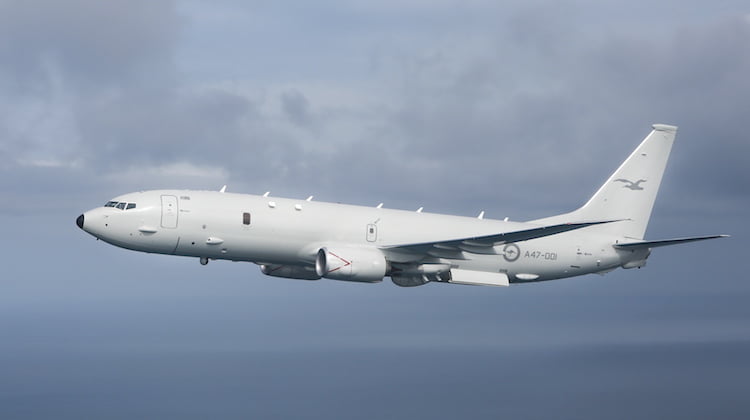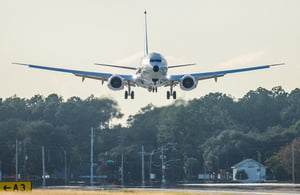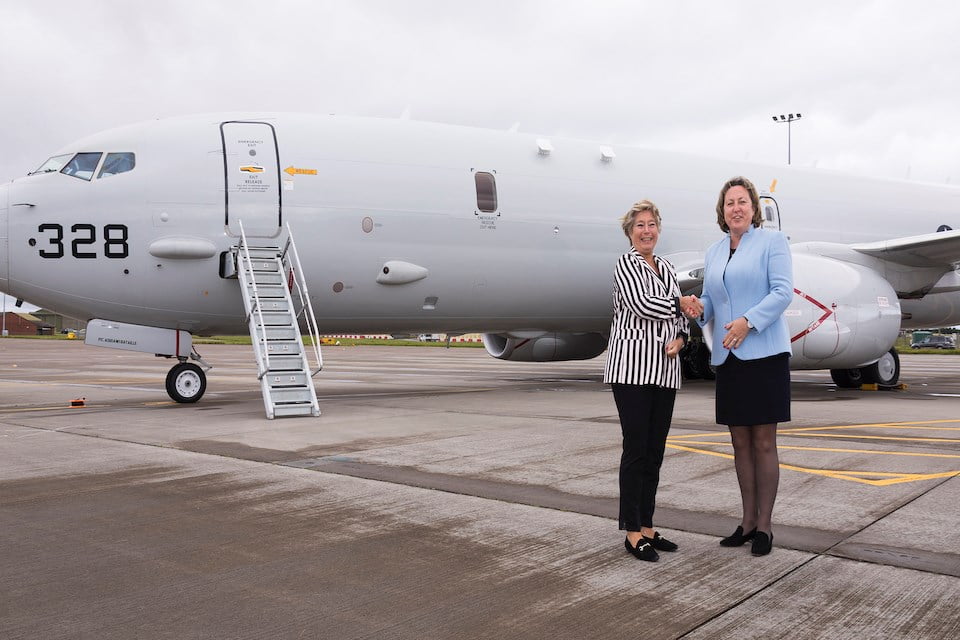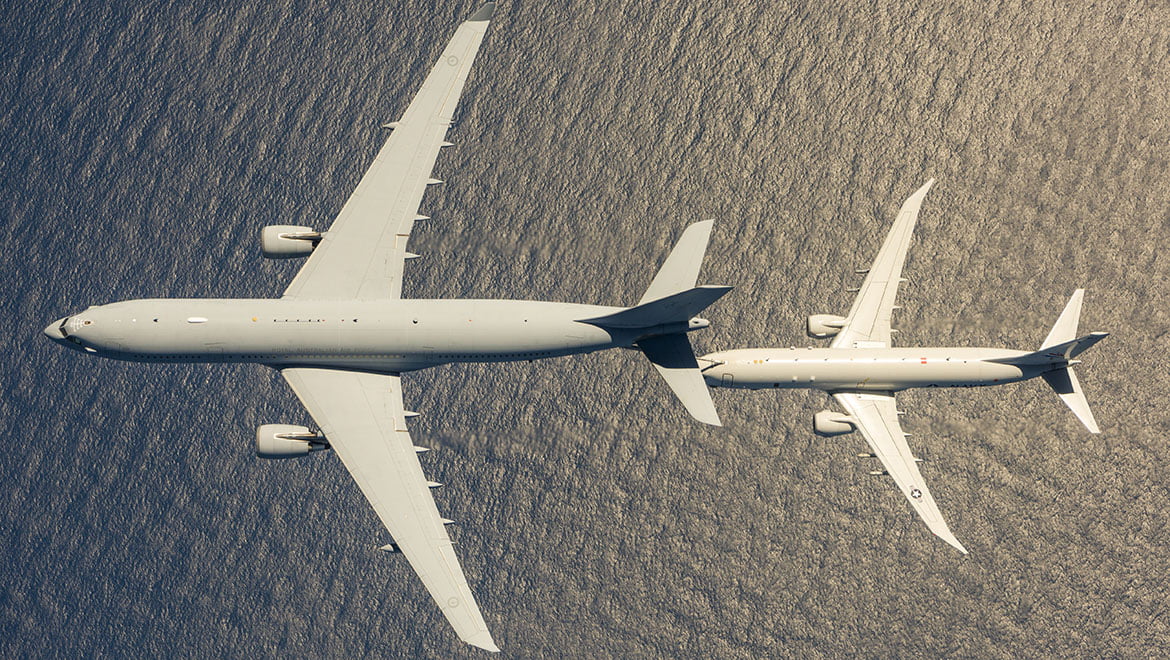We have written about the shaping of a maritime domain awareness enterprise in the North Atlantic to deal with the Russian challenge and the fourth battle of the North Atlantic.
From this piece, which we published on Breaking Defense in 2017:
In effect, an MDA highway being built from Lossie and the F-35 reach from the UK to Northern Europe are about shaping common, convergent capabilities that will allow for expanded joint and combined operational capabilities. At this is not an add on, but built from the ground up.
Flying the same ISR/C2/strike aircraft, will pose a central challenge with regard to how best to share combat data in a fluid situation demanding timely and effective decision-making?
The UK is clearly a key player in shaping the way ahead on both the P-8 and F-35 enterprises, not just by investing in both platforms, but building the infrastructure and training a new generation of operators and maintainers as well. At the heart of this learning process are the solid working relationships among the professional military in working towards innovative concepts of operations. This is a work in progress that requires infrastructure, platforms, training and openness in shaping evolving working relationships.
We are now in November 2019, and can take note of recent developments which highlight shaping the way ahead for the MDA enterprise being shaped by the United States and its core allies.
Given the brains involved on the planes, and in the enterprise, this might suggest that NATO is not exactly “brain dead” as one Western leader recently asserted.
RAAF Poseidon Arrives in the Middle East
In a recent speech given by the head of the 5th Fleet at the BIDEC 19 conference, he focused on the need for expanding the ISR capabilities of the allied forces facing the diversity of threats in the region.
He can now add an RAAF Poseidon to the mix.
A RAAF P-8A Poseidon maritime surveillance aircraft has arrived in the Middle East to conduct operations in support of the International Maritime Security Construct (IMSC).
That’s the US-initiated mission prompted by escalating tensions with Iran amid rising concerns that a tanker war in the Straits of Hormuz could global oil supplies.
As well as the P-8A, Australia has also agreed to provide a warship, the Anzac frigate HMAS Toowoomba, which begins its deployment in January.
Defence Minister Linda Reynolds said the P-8A’s advanced surveillance capabilities will provide a modest but meaningful contribution.
“The P-8A will work alongside our coalition partners to ensure the safe passage of merchant vessels through the region, boost security and provide an advanced maritime patrol and surveillance capability,” she said.
“This is the first time the P-8A aircraft has operated in the Middle East and its deployment will support freedom of navigation in the region, which is a fundamental right of all states under international law.”
Although, no RAAF Poseidon has operated in this area, the RAAF has plenty of experience, flying AP-3C Orion aircraft – predecessor to Poseidon – deployed to the Middle east between 2003 and 2012.
The government says the P-8A Poseidon aircraft will provide an advanced maritime patrol and surveillance capability, to support the safe transit of naval and merchant vessels.

That’s a brief deployment, running to the end of November 2019
The government hasn’t identified the P-8A’s operational base but it’s most like Australia’s longstanding support facility at the al-Minhad Air Base (AMAB) in the United Arab Emirates.
A small number of Australian Defence Force personnel are also serving in the IMSC’S Middle East headquarters in Bahrain.
Australia was an early backer of IMSC whose contributors are the US, UK, Bahrain, Saudi Arabia, UAE, with, according to a report from Israel, some Israeli intelligence support.
Europe has a strong interest in maintaining uninterrupted oil supplies through the Straits of Hormuz. Although invited to contribute to IMSC, no European nation has yet signed on, apparently out of concern at being dragged into the US row with Iran.
RAF Gets its First Poseidon Aircraft
According to a UK Ministry of Defence article published on October 31, 2019:
The MOD is investing £3 billion in nine state-of-the-art jets which will enhance the UK’s tracking of hostile maritime targets, protect the British continuous at-sea nuclear deterrent and play a central role in NATO missions across the North Atlantic.
Defence Secretary Ben Wallace said:
“The arrival of the world-class Poseidon aircraft marks a step-change in the UK’s maritime patrol capability.
“Using the world’s most advanced sensors and operating for long periods, these aircraft will transform the quality of intelligence available to our armed forces and protect our vital nuclear deterrent.”

The first submarine-hunting Poseidon MRA1 Maritime Patrol Aircraft (MPA) has been delivered to the Royal Air Force.
The MOD is investing £3 billion in nine state-of-the-art jets which will enhance the UK’s tracking of hostile maritime targets, protect the British continuous at-sea nuclear deterrent, and play a central role in NATO missions across the North Atlantic.
The aircraft left Boeing Field, Seattle, flying under the callsign POSIDN1, flying across the United States of America, before touching down at Naval Air Station Jacksonville where Air Officer Commanding Number 1 Group, Air Vice-Marshal Harv Smyth, took delivery of the first Royal Air Force P-8A Poseidon.
Following an unveiling ceremony in Seattle, the aircraft was flown to Naval Air Station Jacksonville in Florida where RAF personnel are being trained to operate the aircraft.
On arrival Michelle Sanders, DE&S Delivery Team Leader, signed the paperwork to formally transfer the aircraft, named Pride of Moray, to UK ownership.
Air Chief Marshal Mike Wigston, Chief of the Air Staff, said:
“Poseidon is a game-changing maritime patrol aircraft, able to detect, track and if necessary destroy the most advanced submarines in the world today.
“With Poseidon MRA1, I am delighted and very proud that the Royal Air Force will once again have a maritime patrol force working alongside the Royal Navy, securing our seas to protect our nation.”
First Sea Lord, Admiral Tony Radakin, said:
“Poseidon marks a superb upgrade in the UK’s ability to conduct anti-submarine operations. This will give the UK the ability to conduct long range patrols and integrate seamlessly with our NATO allies to provide a world-leading capability.
“This will maintain operational freedom for our own submarines, and apply pressure to those of our potential foes. I look forward to working with the RAF and our international partners on this superb capability.”
The Poseidon MRA1 is designed to carry out extended surveillance missions at both high and low altitudes. The aircraft is equipped with cutting-edge sensors which use high-resolution area mapping to find both surface and sub-surface threats.
The aircraft can carry up to 129 sonobuoys, small detection devices which are dropped from the aircraft into the sea to search for enemy submarines. The systems survey the battlespace under the surface of the sea and relay acoustic information via radio transmitter back to the aircraft.
The aircraft will also be armed with Harpoon anti-surface ship missiles and Mk 54 torpedoes capable of attacking both surface and sub-surface targets.
Michelle Sanders, DE&S Delivery Team Leader, said:
“Seeing the first Poseidon MRA1 handed over to the Royal Air Force is an incredibly proud moment for all of the team at DE&S.
“Close, collaborative working with colleagues in Air Capability, the US Navy and industry has helped us deliver this very capable aircraft.”
As leading members of NATO, the UK has signed agreements with both the US and Norwegian militaries to cooperate closely on operating their Poseidon fleets across the North Atlantic.
In August this year, Defence Minister Anne Marie-Trevelyan hosted Norwegian State Secretary Tone Skogen at RAF Lossiemouth to deepen the two country’s partnership on the Poseidon programme.
To maintain the skills required to deliver this vital capability, the RAF has embedded aircrew within MPA squadrons in Australia, Canada, New Zealand and the USA.
The first aircraft will arrive in Scotland in early 2020, with the fleet to be based at RAF Lossiemouth in Moray. All nine aircraft will be delivered by November 2021.
The aircraft will be flown initially by 120 Squadron which was originally stood up on 1 January 1918 and was the leading anti-submarine warfare squadron in WWII. 201 Squadron will also join the programme in due course.
The Poseidon MRA1 programme is bringing significant economic benefits to the communities near RAF Lossiemouth. A total of £460 million is being invested in the station to prepare for the arrival of the new aircraft, including the construction of a £132 million strategic facility for the fleet to be completed next year.
The programme will also bring around 700 additional personnel to Moray, taking the total number of employees there to approximately 2,500.
Norway, the UK and the Maritime Domain Awareness Enterprise
In a story published on August 15, 2019 on the Norwegian Ministry of Defence website, the collaboration between the UK and Norway was highlighted in the MDA area.
The UK is investing £3 billion in nine new Boeing Poseidon P-8A maritime patrol aircraft, with Norway committing to a further five. The aircraft are sophisticated submarine-hunters designed to scout complex undersea threats.
The aircraft will work together, and with NATO allies, to combat a range of intensifying threats in the North Atlantic, including increased hostile submarine activity.

Defence Minister Anne-Marie Trevelyan said:
“The UK’s maritime patrol aircraft programme demonstrates our ongoing commitment to working with international allies in the North Atlantic, strengthening our alliances with valued partners such as Norway.
“Our two nations share basing facilities, undergo cold weather training together and patrol the seas and skies side-by-side allowing us to successfully face down the growing threats from adversaries in the North Atlantic region.”
During the visit, the defence ministers experienced a demonstration flight in a US Navy Poseidon P-8A aircraft.
Norwegian State Secretary Tone Skogen said:
“The UK and Norway have a long history of cooperation on maritime surveillance and operations. This close relationship will only improve now that we will operate the same type of MPA, the P-8 Poseidon. UK and Norwegian priorities are aligned in the North Atlantic, and we look forward to a close and integrated partnership in meeting common challenges within the realm of maritime security.”
Fifth Generation Maritime Domain Awareness Capabilities
Recently, the Williams Foundation held its latest seminar on fifth generation force development.
In preparation for the seminar, Squadron Leader Melissa Houston, a P-8A tactical co-ordinator and flight commander in the Royal Australian Air Force, provided her perspective on what the Poseidon and ultimately what the Triton will bring to the fight.
What does fifth-generation manoeuvre mean in the context of airborne anti-submarine warfare? Fifth-generation, a term typically applied to fighters, encompasses highly integrated net-enabled systems within a high-performance stealth airframe. The P-8A Poseidon, the Royal Australian Air Force’s (RAAF) only maritime patrol aircraft, lacks the stealth and manoeuvrability of a fifth-generation fighter but arguably holds fifth-generation ‘systems equivalence’ due to its advanced avionics, sensors and extensive communications suite. The P-8A is designed to engage in underwater warfare, where submarines are the primary threat. In order for the submarine threat to be defeated, however, the P-8A must successfully integrate with the broader Australian Defence Force (ADF). This post will describe the strategic value the Poseidon brings to the ADF, outline the critical roles of the P-8A, and identify some of the critical challenges faced in realising that potential.
The Australian government acknowledges the array of challenges to national security created by a contested maritime environment. The 2016 Defence White Paper sets a requirement to secure Australia’s northern approaches and proximate sea lines of communication, while also securing the near region, encompassing maritime South East Asia and the South Pacific. Understanding the P-8A’s value in meeting these requirements require a dive beneath the surface to analyse subsurface strategic value.
A secure Australia depends upon protection from attack or coercion. Submarines play a vital role on both sides of this equation. Uncertainty as to the location and purpose of Australia’s submarines acts as a critical deterrent to a potential adversary. The reverse is true of potential opponents’ submarines. Anti-submarine warfare limits an adversary submarine’s ability to achieve sea denial, conduct intelligence activities, insert land forces or conduct missile strikes. Critically, friendly anti-submarine warfare enhances the effectiveness of friendly submarines by disrupting opposing submarine operations. The maintenance of an effective anti-submarine warfare capability allows the ADF to detect and disrupt a key threat to Australia while enhancing the potency of its undersea deterrent.
The P-8A makes a unique contribution to Australia’s joint anti-submarine warfare capability as the ADF’s only fixed-wing aircraft that can find, fix, track, and attack an underwater target. The P-8A’s speed and range – it can operate over 2000 kilometres from its base – complement the persistence and presence of Australia’s surface and sub-surface anti-submarine capabilities. Range and responsiveness are particularly valuable when considering the reach of the world’s leading submarines.
The P-8A’s ability to operate at range while maintaining real-time communication with various agencies, combined with its sensor and data feeds, makes it an extremely valuable asset. The P-8A acoustics system has four times the processing capability of the recently retired AP-3C Orion. The P-8A can, therefore, provide four times the coverage or four times the security in an anti-submarine warfare search. The use of advanced sensors and processing are critical elements of the P-8A’s fifth-generation potential.
However, the P-8A’s lack of stealth, low speed, and limited defensive systems leave it vulnerable to increasingly sophisticated threats in the maritime domain. The P-8A has demonstrated performance in congested environments but has yet to be employed in contested environments.
Importantly, congestion in 2019 is more than a problem of dense shipping on the ocean’s surface. The P-8A faces emerging challenges in a competitive and cluttered electromagnetic spectrum, resulting in global positioning system interference, radar interference and jamming. As the P-8A’s performance is optimised as part of a highly networked fifth-generation force, disruption in the electromagnetic spectrum has the potential to reduce mission effectiveness significantly. Accordingly, the RAAF must continue to evolve how the P-8A is employed.
There are several challenges facing the P-8A fleet in exploiting its potential. Resolving issues in human factors, technical integration, and command and control will help the ADF realise the Poseidon’s potential.
There is little benefit in P-8A sensors and communications suites integrating with other platforms if operators are not adequately trained to exploit the data being received and know where it must feed. When it comes to fifth-generation manoeuvre, people often get excited by the high-end warfare integration components, sometimes at the expense of basic concepts. Integration is first and foremost about co-operating safely and becoming fifth-generation does not remove the threat of fratricide or accident. Understanding other platform limitations is key to successful (and safe) operations in a congested and contested environment.
We must remain cognizant of the current limitations of our successful integration across ADF platforms. We must continue to develop, test and adjust joint tactics, techniques, and procedures. In an increasingly complex subsurface environment, the safe and successful prosecution P-8A’s missions, especially anti-submarine tasks, must be joint actions.
Improved understanding and integration of joint combat and support systems will enable the development of a joint concept of operations. The age of information means that aircrew is more likely to be overwhelmed with the amount of information they are being fed in real-time by various agencies. This hyper-connectivity can lead to poor prioritisation and breakdowns in situational awareness. The ADF must understand the limitations of our autonomous systems – but also that of our people. Fifth-generation operators must have more discipline and self-awareness than ever before.
A key component of success in fifth-generation manoeuvre is real-time, net-enabled operations. The ADF’s machines must understand one another’s data language for net-enabled operations to be feasible, just as much as the people on board need to understand each other. An example from recent exercise is the requirement for further development of joint procedures across RAAF and Royal Australian Navy elements ensure that datalink messages are transmitted and received as intended. This is paramount in targeting and employing net-enabled weapons. There is no fifth-generation force if the fifth-generation platforms cannot communicate assuredly across the force.
Importantly, with the rise of challenges in the electromagnetic spectrum, ADF systems and people must become adept at operating in analogue or degraded communications modes. Building trust and confidence in systems, in people, and in systems of systems is key to exploiting the Poseidon’s potential.
Finally, with the P-8A’s ability to be re-tasked for any number of missions, command and control is more complicated than ever. Assets can be reassigned in real-time, and aircrew must have a clear understanding of their C2 arrangements, particularly where an asset is dually assigned or where it has separate operational and tactical control arrangements.
The P-8A will absorb the AP-3C’s legacy tasking, stretched across air power roles while integrating seamlessly with civilian agencies in search and rescue roles and ADF and coalition partners across the maritime and land domains. Real-time intelligence updates also mean that the P-8A can act and react in response to the evolving threat environment. Evolution of tasking processes and authorities must evolve to a fifth-generation way of thinking to exploit, rather than limit, the potential of advanced systems.
The P-8A Poseidon brings new potential to the ADF, particularly in its primary underwater warfare role. A fifth-generation maritime patrol aircraft optimises its sensors, communications, and crew as part of an integrated force, and leverages those resources to be more effective and efficient in disrupting adversary submarines and enhancing friendly operations.
Australia’s P-8A fleet has already demonstrated performance in congested environments and gained experience in several operational theatres. P-8A operations, as part of a fifth-generation force, must continue to evolve to achieve the Poseidon’s fifth-generation potential. The ADF must work through challenges in human factors, technical integration, and C2 to unlock Poseidon’s potency.
The featured photo shows an Australian KC-30A Multi Role Tanker Transport (MRTT) from 33SQN, operated by the Aircraft Research and Development Unit, conducts aerial refueling compatibility flight testing over the Atlantic Ocean with a United States Navy P-8A Poseidon from Air Test and Evaluation Squadron Two Zero.


